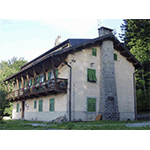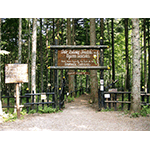Ecomuseo della Montagna Pistoiese - Orto Botanico Forestale dell'Abetone [Ecomuseum of the Pistoian Mountains - Abetone Forestal Botanical Garden]
Strongly desired by scholar of alpine flora Federico Strada, planning of the garden got underway as of the 1980s: in 1986 a consortium was founded, made up of various institutions to manage the activities (the Regional Administration of Tuscany, the State Foresters Corps, the Mountain Community of the Pistoian Apennines, and the Universities of Florence, Pisa and Siena), and it was inaugurated in 1987.
The Garden seeks to promote the area’s forestal aspects, of which the nearby Campolino Oriented Nature Reserve is the most significant example. Instituted in 1972, the Reserve preserves the last remains of indigenous woods of red fir (Picea abies), as well as firs, beech and high-trunk trees. The Garden is divided into "theme" areas, including a wetland with a small peat-bog, a calcareous rocaille and a siliceous rocaille with many species of flora typical of Pistoian Apennine altitudes (gentians, saxifrages, primulas, bilberries, lilies, orchids). The term "rocaille" (from the French) indicated several bizarre rustic architectures, decorated with artificial stalactites and shells, common in Italian gardens in the 17th and 18th centuries.
The Botanical Garden is also the point of departure of two itineraries: one of these leads to the reserve of red fir trees (Picea abies) of Campolino, while the other traverses the woods of the upper Val Sestaione, arriving up to Regine. The route is completed by the Fontana Vaccaia Learning Centre, housed since 1997 in the Foresters Corps Station. The availability of specific bibliographic material, equipment for studying plants, and a room for viewing films and slides, make it an ideal centre for research and science dissemination activities. A small natural science museum is presently being set up and will exhibit typical manufactures of the Pistoian mountains, as well as an herbarium containing numerous dried specimens of the local flora.
****************************
Texts by Anna Toscano
English translation by Victor Beard
Last update 15/gen/2008





